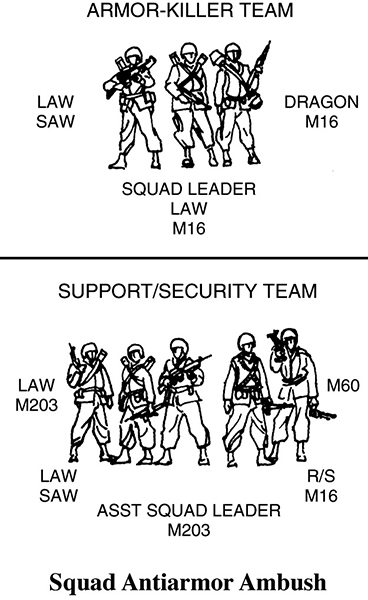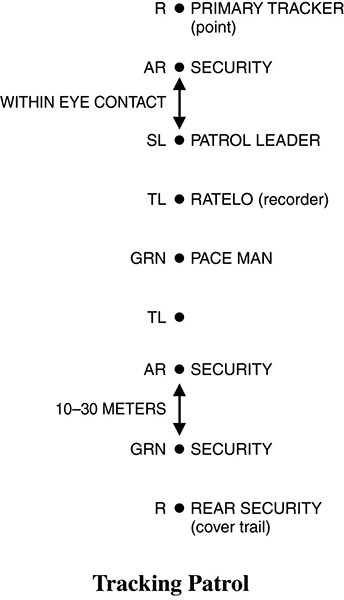
L-Shaped Ambush
In an L-shaped ambush, the assault element forms the long leg parallel to the enemy’s direction of movement along the kill zone. The support element forms the short leg at one end of and at a right angle to the assault element. This provides both flanking (long leg) and enfilading (short leg) fires against the enemy. The L-shaped ambush can be used at a sharp bend in a trail, road, or stream. It should not be used where the short leg would have to cross a straight road or trail.
Antiarmor Ambush
The purpose of an antiarmor ambush is to destroy armored vehicles. A squad can conduct a dismounted antiarmor ambush, organizing into an armor-killer team and a support-and-security team. The armor-killer team fires into the kill zone. Normally, the Dragon is the main weapon of this team. Where fields of fire are less than 100 meters, light antitank weapons (LAWs) may be the main antiarmor weapon. In that case, the armor-killer team must mass LAW fires into the kill zone to make sure the enemy vehicle is destroyed. The support-and-security team provides security and should be positioned where it can cover the withdrawal of the armor-killer team.

At the Ambush Site. When the squad arrives at the ambush site, the leader reconnoiters and picks the kill zone. Good positions have the following attributes:
•Good fields of fire.
•Cover and concealment.
•An obstacle between the teams and the kill zone.
•Covered and concealed withdrawal routes.
Establishing an Antiarmor Ambush. Position a support-and-security team first, and provide security on both flanks. Position the Dragon and then the machine gun so they can cover the kill zone.
The leader initiates the ambush when the enemy enters the kill zone. A command-detonated antiarmor mine is an excellent means of initiating the ambush. The Dragon may be used to initiate the ambush, but it has a slow rate of fire, gives off a signature, and may not hit the target. When possible, the first and last vehicles of a column should be destroyed to keep other vehicles from escaping.
The rest of the squad opens fire when the ambush is initiated. Indirect fires should fall into the kill zone as soon as possible. If the kill zone is in range, squad members fire a LAW.
If enemy dismounted troops precede the armored vehicles, the squad leader must decide whether they pose a threat to the ambush. If they can outflank his squad before the enemy armor can be hit, he may decide to withdraw and set up another ambush somewhere else.
RAID
A raid is a combat operation to attack a position or installation followed by a planned withdrawal. Squads do not execute raids. The sequence of platoon actions for a raid is similar to that for an ambush. Additionally, the assault element of the platoon may have to conduct a breach of an obstacle. It may have additional tasks to perform on the objective: for example, demolition of fixed facilities.

TRACKING PATROL
Platoons and squads may receive the mission to follow the trail of an enemy unit. Even while tracking, they still gather information about the enemy, the route, and surrounding terrain.
Training
Soldiers must be taught to move stealthily and well trained in tracking techniques. Once soldiers are deployed into an area of operation, training continues so that the platoon can learn about local soil, climate, vegetation, animals, vehicles, footwear, and other factors.
Organization
When the platoon receives the mission to conduct a tracking patrol, it assigns the task of tracking to only one squad. The remaining squads and attachments provide security.
Trail Signs
Men, machines, and animals leave signs of their presence as they move through an area. These signs can be as subtle as an odor or as obvious as a well-worn path. All soldiers can read obvious signs such as roads, worn trails, or tracks in sand and snow. However, attention to detail, common sense, alertness, logic, and knowledge of the environment and enemy habits enable soldiers to obtain better information from signs they find in the battle area.
Trail and Sign Analysis. Once the first sign is discovered, it must not be disturbed or covered and should be analyzed carefully before the patrol follows the enemy. If the sign is found at the site of enemy activity, the exact occurrence can often be reconstructed. If a trail is the first sign found, the tracker can still determine such facts as the size and composition of the groups being tracked, their direction, and their general condition. The tracker must determine as much as possible about the enemy before following it. His knowledge of the enemy continues to grow as he finds additional signs.
Finding the Trail. Finding the trail is the first task. The tracking team can reconnoiter around a known location of enemy activity when the trail cannot be found in the immediate area. There are two ways to hunt for a trail:
1.The tracking team can locate and follow the enemy’s trail from a specific area or location where the enemy has been seen. This can be a camp or base or the site of an enemy attack or enemy contact.
2.The route of a friendly unit may cross a trail left by an enemy group. This can be by chance, or the team can deliberately take a route it believes will cut across one or more probable enemy routes.
Regaining a Lost Trail. If the tracker loses the trail, he immediately stops. The tracking team then retraces its path to the last enemy sign and marks this point. The team studies the sign and the area around it for any clue as to where the enemy went. It looks for signs that the enemy scattered, backtracked, doglegged, or used any other countertracking method. If the trail still cannot be found, the team establishes security in a spot that avoids destroying any sign. Then the tracker and an assistant look for the trail by “boxing” the area around the last sign. The tracking team always returns to the same path, away from the last sign, to create as few trails as possible.
PRESENCE PATROL
US forces are deployed increasingly in support of stability and support operations (SASO) missions all around the world. The infantry platoon plans and conducts a presence patrol much the same as a combat patrol. The primary difference is that the patrol wants to both be seen as a show of force and to lend confidence and stability to the local population of the host nation. As its name implies, this patrol is constituted to achieve a presence. It can be used only if a peace agreement has been negotiated between belligerents. The presence patrol is armed, and it conducts the planning and preparation necessary for combat operations at all times. The patrol can be used as a component of a larger force conducting stability and/or support operations.
The platoon could be tasked to conduct mounted (if augmented with vehicles) or dismounted patrols planned by the higher headquarters to accomplish one or more of the following:
•Confirm or supervise an agreed ceasefire.
•Gain information.
•Cover gaps between OPs or checkpoints.
•Show a stability force presence.
•Reassure isolated communities.
•Inspect existing or vacated positions of former belligerents.
•Escort former belligerents or local populations through trouble spots.
PATROL BASES
A patrol base is a position set up when a squad or platoon conducting a patrol halts for an extended period. When the unit must halt for a long time in a place not protected by friendly troops, it takes both active and passive security measures. Patrol bases should be occupied no longer than twenty-four hours and the same one is never used twice. Patrol bases are used for the following purposes: